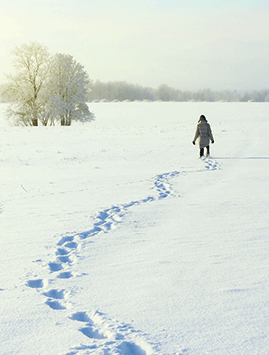Winter walking

Winter can be an exhilarating time to go out walking in the fresh air, but make sure you keep safe with our experts’ advice
It can be all too tempting to hide away and hibernate during the long winter months, but getting out into the countryside and going for a bracing walk can really help to lift your spirits. “Going out for a winter walk will not only help your physical health but the fresh air, exercise and scenery can really boost your mood,” says Simon Barnett, director of walking development at the Ramblers (www.ramblers.org.uk). However, it’s important to plan ahead when you are going walking in the winter as the short daylight hours and the possibility of snow and ice can lead to problems. “Stay safe, know your limits, and be prepared, but make sure you have fun,” says Carey Davies, hill walking development officer with the British Mountaineering Council (www.thebmc.co.uk).
Make an early start
“We always advise people to take care when walking in mountainous regions during the winter,” says Simon. “Check the weather before you set off, plan walks carefully to take account of the early sunset and make sure you have the right equipment with you, including warm clothes.” A head torch is an invaluable piece of equipment and it’s a good idea to take a back-up torch as well. “The short hours of daylight can often catch people out which is why it’s a good idea to make an early start during winter,” says Carey.
Layer up
“It’s particularly important in winter that you wear footwear and clothing to suit the weather conditions,” says Simon. “As long as you’re prepared, you can still enjoy a great day outdoors. Wear plenty of warm clothes, a waterproof coat and footwear, and a warm hat and gloves. Several thin layers are better than one thick layer – warm air gets trapped between the layers and provides insulation, and you can add or remove layers as the temperature changes. Choose materials which direct moisture away from the skin and dry quickly – avoid cotton which absorbs sweat.”
Choose sturdy footwear
“If you’re not doing any technical walking you can use the same type of footwear you might use in summer as long as it’s robust enough,” says Carey. “During summer I tend to wear fairly lightweight trail shoes but during winter I will go for boots or shoes with a bit more ankle support and which are waterproof and provide me with a bit more warmth. If it’s icy then you might want to invest in some Yaktrax, which are lightweight ice grips that you wear over your regular shoes or boots and which give you a bit more grip when you’re walking on country lanes or footpaths. They are great for lowland walking but not suitable for high level walks, where you would need crampons.”

Plan your route carefully
Before you set off, make sure you plan your route in advance and take a map and compass with you (and make sure you know how to use them!) “The Ordnance Survey website is a great resource for maps,” says Carey. “If you are taking a paper map then the Explorer and Landranger series are good options. You can also get various apps like ViewRanger and RouteBuddy that contain mapping software which you download onto your phone and use with the phone’s GPS.” In terms of planning a walking route, know your limits and stick to them. “You can often end up biting off more than you can chew in winter,” says Carey. “You get a lot more tired and burn more calories when you’re walking in the cold so be more conservative when it comes to route planning.”
Pack some healthy snacks
You will be expending a lot of energy if it is particularly cold and you are planning a long walk so it’s essential to take some snacks to keep your energy levels up. Pack a flask containing some warming herbal tea or vegetable soup and make sure you have plenty of water on you to keep yourself hydrated. Low sugar flapjacks and granola bars made from nuts and seeds will help to sustain you on your walk.
Take a first aid kit
A first aid kit is an essential item to bring on your winter walks. Good things to include in it are assorted plasters, bandages, zinc oxide tape, sterile wound dressings, sterile cleansing wipes, tweezers and scissors. Also bring a whistle with you to attract attention and a head torch that has an emergency flash setting. You might even want to pack a foil survival blanket in case of emergency. Make sure you bring a fully-charged mobile phone with you and make sure someone knows where you’ve gone and when you expect to be back.
Head for the coast
“Coastal areas are really nice places to go for walks during the winter because navigation is relatively straightforward,” says Carey. “They can be very bright because you get the reflection off the sea and you also get quite a lot of bird life, so it tends to be a bit more lively and interesting. Places like the Jurassic Coast and the Vale of Glamorgan coastline are good options. Once you’ve grown accustomed to the elements you can think about going out on the hills a bit more.”
Remember to be prepared, keep safe and enjoy yourself!
Read previous Your Outdoor Living articles here...